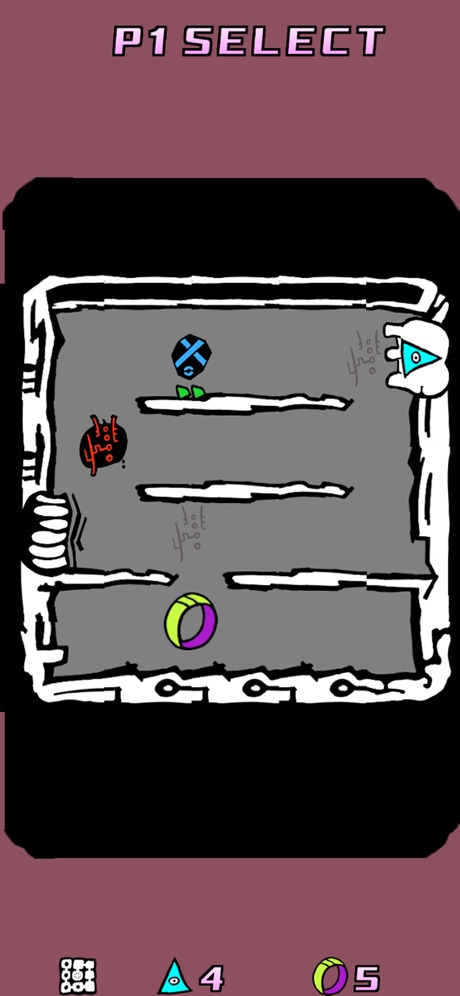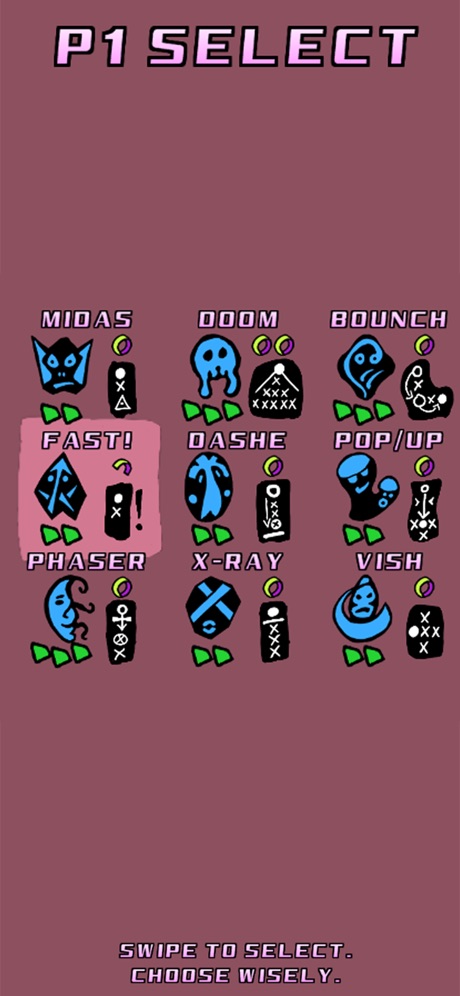 I think it’s pretty well-established by now that Michael Brough makes some truly excellent games. Oh, they don’t always look pretty, though I’m rather fond of the quirky art style he’s adopted from Imbroglio onward. It’s safe to say he has a genre of choice as well, with most of his work falling rather firmly into that squishy genre we usually call roguelites. But within that little slice of the market, there’s frankly no name I trust more than his. I think it’s because when it comes down to it, these games all offer a tremendous amount of replay value without sacrificing the player’s agency in their fate. That is a harder balance to strike than you might think. And yet time after time, game after game, Michael Brough steps up to the challenge. His latest is no exception.
I think it’s pretty well-established by now that Michael Brough makes some truly excellent games. Oh, they don’t always look pretty, though I’m rather fond of the quirky art style he’s adopted from Imbroglio onward. It’s safe to say he has a genre of choice as well, with most of his work falling rather firmly into that squishy genre we usually call roguelites. But within that little slice of the market, there’s frankly no name I trust more than his. I think it’s because when it comes down to it, these games all offer a tremendous amount of replay value without sacrificing the player’s agency in their fate. That is a harder balance to strike than you might think. And yet time after time, game after game, Michael Brough steps up to the challenge. His latest is no exception.
 There is something a little different about P1 Select ($3.99), however. If this is your first experience with one of his games you may or may not believe me, but this is a kinder, gentler Brough game. It’s not as complex as Imbroglio ($3.99), nor is it as hard to come to grips with initially as 868-HACK ($7.99). As such, it’s a great introduction into the wild world of Brough’s creations. If you’re a veteran, don’t worry. There’s still plenty here to chew on, even if it may not quite have the longevity of some of his other titles. Your aim in P1 Select is to make your way through nine procedurally-generated stages, gathering as many Pontos as you can along the way. You’ll get one Ponto for every floor you clear, but you can earn extra Pontos by defeating enemies in a particular way. Whether you make it to the end of the nine stages or perish along the way, the number of Pontos you collect is tallied up and recorded. A single good run isn’t enough, however, as P1 Select keeps track of your average score across 20 sessions, and that’s what the leaderboard rankings are based on.
There is something a little different about P1 Select ($3.99), however. If this is your first experience with one of his games you may or may not believe me, but this is a kinder, gentler Brough game. It’s not as complex as Imbroglio ($3.99), nor is it as hard to come to grips with initially as 868-HACK ($7.99). As such, it’s a great introduction into the wild world of Brough’s creations. If you’re a veteran, don’t worry. There’s still plenty here to chew on, even if it may not quite have the longevity of some of his other titles. Your aim in P1 Select is to make your way through nine procedurally-generated stages, gathering as many Pontos as you can along the way. You’ll get one Ponto for every floor you clear, but you can earn extra Pontos by defeating enemies in a particular way. Whether you make it to the end of the nine stages or perish along the way, the number of Pontos you collect is tallied up and recorded. A single good run isn’t enough, however, as P1 Select keeps track of your average score across 20 sessions, and that’s what the leaderboard rankings are based on.
There are nine different characters to play as, and you can choose who you start with each time. But you’ll be playing all of them regardless of who you start with. Every step you take shifts you to a different character. You can see ahead of time which one it will be. Attacking an enemy will also change out your character. Each character has a different way of attacking, somewhat like a chess piece. They all use rings to power their attacks, with most taking a single ring. The key character here is Midas, who has the ability to change an enemy into a Ponto when it attacks. Certainly, other characters have their uses. Some can jump over walls. Some can take out multiple enemies in one go. And they all will leave you in different positions after using their moves. All of those things can be valuable given that you’re ultimately playing a game of energy conservation and positioning here.
You can’t attack without rings, but the rings may not be within easy reach. If you defeat all of the enemies, your character will scoop up the remaining rings before leaving the room. You can walk out the exit door anytime you like provided you can reach it, however. So you really have to consider whether you can save more rings by fighting or by running. But you also need to think about making opportunities to use Midas for extra Pontos. And no matter what you do, sooner or later you are going to have to fight. Naturally, all of this comes after the basic goal of making sure you don’t die a stupid death, which can happen pretty easily if you’re not cautious. It’s a lot to take in at first, though perhaps not as much as there usually is in one of Brough’s games. You really just have to learn what each character can do and be careful not to box yourself in. Easier said than done.
 Everything in P1 Select looks and sounds weird in that now-familiar Brough style. That said, it’s always clear what everything is. All of the different characters, along with their abilities and position on the grid, are always at the top of the play area, so the amount you have to memorize is relatively limited. If you reach certain score thresholds, you’ll unlock a few permanent upgrades that will help you push your score even higher. As mentioned, there is a leaderboard in the game, and you have your choice of two different control layouts thanks to a post-release update. The default method requires two fingers and while it does feel good, it’s sometimes not practical to use. You can switch to a single-finger control method that works just as well and is easier to pass off as sending an email to HR or whatever it is the important management people do these days. Either way, it’s not too hard to play the game. Swipe to move. Either hold two fingers or tap to set up an attack, then swipe in the desired direction to let fly.
Everything in P1 Select looks and sounds weird in that now-familiar Brough style. That said, it’s always clear what everything is. All of the different characters, along with their abilities and position on the grid, are always at the top of the play area, so the amount you have to memorize is relatively limited. If you reach certain score thresholds, you’ll unlock a few permanent upgrades that will help you push your score even higher. As mentioned, there is a leaderboard in the game, and you have your choice of two different control layouts thanks to a post-release update. The default method requires two fingers and while it does feel good, it’s sometimes not practical to use. You can switch to a single-finger control method that works just as well and is easier to pass off as sending an email to HR or whatever it is the important management people do these days. Either way, it’s not too hard to play the game. Swipe to move. Either hold two fingers or tap to set up an attack, then swipe in the desired direction to let fly.
P1 Select is a more accessible game, and as a result I ended up treating it more like something to play when I had a few spare minutes rather than a game to settle into for longer sessions. I like that its scoring system being so straightforward and clear. On the other hand, it does feel like it’s lacking just a little in depth when compared to some of Brough’s other games. I still play 868-HACK and Imbroglio fairly regularly, but I’m not fully confident I’ll still be playing this game years from now. Is that a big problem? For how little these games sell for, I should hope not. Even if I were to quit playing it tomorrow, an unlikely possibility if ever there were one, P1 Select would have provided me with a full week of taking over my phone in my free time and my thoughts in my not-so-free time.
It’s a no-brainer purchase if you’ve liked any of Brough’s previous games, of course. But if that’s you, then you’ve probably already bought it, haven’t you? If, however, you bounced off one of his games before for any reason other than the art, you might want to give this one a glance. There’s a concerted effort here to try to reach out to a slightly different set of tastes, and if you give it a chance to get its claws into you, you may end up finding this to be the gateway to a brighter, Broughier world. Wouldn’t that be wonderful?